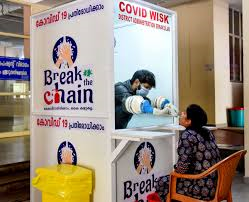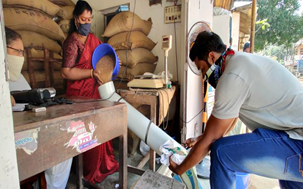Five months on since the country’s first positive case of Novel Coronavirus Disease (COVID-19) was reported in Kerala, the state with over a population of 35 million, has reported 4189 cases of COVID-19 as on 30 June 2020 and 23 deaths with an impressive recovery rate of 51.7%.
 The state government’s prompt response to COVID-19 can be attributed to its experience and investment made in emergency preparedness and outbreak response in the past during Kerala floods in 2018 and especially, the NIPAH outbreak in 2019. The state used innovative approaches and its experience in disaster management planning came in handy to quickly deploy resources and put up a timely and comprehensive response in collaboration with key stakeholders. Active surveillance, setting up of district control rooms for monitoring, capacity-building of frontline health workers, risk communication and strong community engagement, and addressing the psychosocial needs of the vulnerable population are some of the key strategic interventions implemented by the state government that kept the disease in control.
The state government’s prompt response to COVID-19 can be attributed to its experience and investment made in emergency preparedness and outbreak response in the past during Kerala floods in 2018 and especially, the NIPAH outbreak in 2019. The state used innovative approaches and its experience in disaster management planning came in handy to quickly deploy resources and put up a timely and comprehensive response in collaboration with key stakeholders. Active surveillance, setting up of district control rooms for monitoring, capacity-building of frontline health workers, risk communication and strong community engagement, and addressing the psychosocial needs of the vulnerable population are some of the key strategic interventions implemented by the state government that kept the disease in control.
A high-level committee led by the Chief Minister, Health Minister, Chief Secretary and the Principal Secretary (Health) has been set up to monitor, coordinate and guide actions in the field. The State Control room led by the Principal Secretary, Mission Director, National Health Mission, Directorate of Health Services, and Directorate of Medical Education; and its various sub-committees are closely monitoring the various aspects of COVID-19 response. Early release of technical guidelines on contact tracing, quarantine, isolation, hospitalization, infection prevention and control, and extensive capacity-building for all cadres of health and other interlinked departments played a critical role in managing the situation.
Early preparation was the key
The leadership helmed a robust response to the novel coronavirus disease very early, following the news of outbreak in China in January 2020. As the state registered India’s first COVID-19 case on 30 January 2020, the Government declared a health emergency in the state, after two more cases were confirmed on February 2 and 3, 2020. The initial response focused on surveillance and screening of all incoming passengers from China and others who had come in close contact with these travelers. The State Emergency Operations Centre (SEOC) and the office of Kerala State Disaster Management Authority provided support to the Health Department for response and mitigation efforts. Response to an outbreak of this severity and seriousness requires a collaborative and participative approach. The enabling environment owing to the high literacy rate in the state and high-level political and administrative commitment provided the much-needed impetus in the fight against this pandemic.
Systemic investment in strengthening health infrastructure
The government has been systematically investing in strengthening its health infrastructure. During the pandemic, the state government set-up at least two COVID-19 dedicated hospitals in each district to treat the positive cases with well-trained staff and team from all specialities. State and District Medical Boards were constituted to bring out treatment and discharge protocols and assess each positive case.
Early screening of all the incoming passengers was put in place at all the airports and sea ports in the state. When the cases started rising in the country, incoming passengers from other states at Inter State Bus and train terminals were also screened.
Testing and containment strategy

Considering the increase in the number of cases, the state strengthened the surveillance and control measures against the disease. Intense contact tracing and testing are the mainstay of the state’s COVID-19 response. The state adapted WHO’s guidance by tracing, testing and isolating as many as possible.
 As on 30 June 2020, Kerala had sent 1 71 846 samples for testing. In addition, more than 46 689 samples were taken from high-risk groups like health care workers as part of the sentinel surveillance carried out in all 14 districts in the state to check the prevalence of a disease in a community or population. Further, 1193 samples have been tested from three districts, Ernakulam, Thrissur and Palakkad by ICMR in Kerala as part of ICMR Sero-surveillance study. True NAAT and CB NAAT (Xpert-SARS-CoV testing) has been initiated in eight government institutions and nine private institutions for testing samples for patients undergoing an emergency surgery, symptomatic health workers, sick patients or COVID suspected death.
As on 30 June 2020, Kerala had sent 1 71 846 samples for testing. In addition, more than 46 689 samples were taken from high-risk groups like health care workers as part of the sentinel surveillance carried out in all 14 districts in the state to check the prevalence of a disease in a community or population. Further, 1193 samples have been tested from three districts, Ernakulam, Thrissur and Palakkad by ICMR in Kerala as part of ICMR Sero-surveillance study. True NAAT and CB NAAT (Xpert-SARS-CoV testing) has been initiated in eight government institutions and nine private institutions for testing samples for patients undergoing an emergency surgery, symptomatic health workers, sick patients or COVID suspected death.
Isolation of high-risk contacts
The government instituted a longer quarantine of 28 days initially and built thousands of shelters for migrant workers stranded by the nationwide shutdown. Further, COVID Care Centers have been established in all districts to accommodate non-residents such as tourists, people in transit etc. Adequate infrastructure has been provided at all designated isolation facilities for accommodating residents returning from other states. As on 29 June 2020, 180 617 people are under surveillance out of which, 177 955 are under home and institutional quarantine, and 2662 are in designated isolation facilities. Regular monitoring, a mix of phone calls and home visits, is being undertaken to ensure strict adherence.
Providing psychosocial support : Tele medicine portal e-sanjeevani for Tele consultation across the State and Ottakalla oppamundu for providing psychosocial support are in place and 1143 mental health professionals, including psychiatrists, psychiatric social workers, clinical psychologists and counsellors have been deployed to provide support to people in quarantine. Counselling service is also provided to frontline workers working in corona outbreak control activities. The government has adopted an inclusive approach and addressed the special needs of mentally-ill patients, children with special needs, migrant labourers and elderly people living alone. Till date, the psychosocial services have reached out to 11 68 950 people in the state by providing them an enabling environment to deal with stress related to the novel coronavirus outbreak.
: Tele medicine portal e-sanjeevani for Tele consultation across the State and Ottakalla oppamundu for providing psychosocial support are in place and 1143 mental health professionals, including psychiatrists, psychiatric social workers, clinical psychologists and counsellors have been deployed to provide support to people in quarantine. Counselling service is also provided to frontline workers working in corona outbreak control activities. The government has adopted an inclusive approach and addressed the special needs of mentally-ill patients, children with special needs, migrant labourers and elderly people living alone. Till date, the psychosocial services have reached out to 11 68 950 people in the state by providing them an enabling environment to deal with stress related to the novel coronavirus outbreak.
Risk communication and community engagement
 An awareness campaign ‘Break the Chain’ was successful in promoting the importance of hand hygiene, physical distancing and cough etiquette. Hand washing stations were installed in strategic locations, including exit and entry points of railway stations etc. to instill a behaviour change. The Kerala Arogyam portal was launched by the Department of Health and Family Welfare with comprehensive information on COVID-19. Covid Jagratha portal and Directorate of Health Services website was launched by the Department of Health and Family Welfare with comprehensive information on COVID-19.
An awareness campaign ‘Break the Chain’ was successful in promoting the importance of hand hygiene, physical distancing and cough etiquette. Hand washing stations were installed in strategic locations, including exit and entry points of railway stations etc. to instill a behaviour change. The Kerala Arogyam portal was launched by the Department of Health and Family Welfare with comprehensive information on COVID-19. Covid Jagratha portal and Directorate of Health Services website was launched by the Department of Health and Family Welfare with comprehensive information on COVID-19.
 The high literacy rate in the state and the empowered women self-help groups -Kudumbashree helped the cause in a big way. Kudumbashree formed close to 1.9 lakh WhatsApp groups with 22 lakh neighbourhood groups (NHGs) to educate on key safety measures as advocated by the government during lockdown.
The high literacy rate in the state and the empowered women self-help groups -Kudumbashree helped the cause in a big way. Kudumbashree formed close to 1.9 lakh WhatsApp groups with 22 lakh neighbourhood groups (NHGs) to educate on key safety measures as advocated by the government during lockdown.

Community Kitchen initiative through the Local Self Government Department (LSGD) with the support of Kudumbasree has provided more than 8 651 627 free meals to the labourers, those who are in quarantine, isolation, destitute and other needy persons. Distribution of millions of cooked meals and provision of free ration under the Public Distribution Scheme to those in need is reflective of a well-thought and a caring response and relief strategy.
“Kerala’s model of controlling epidemic has its roots in the strong health system we built over the years. Our Hon’ble CM and Health Minister led from the front and facilitated inter-sectoral coordination as well as community participation. We focused on the strategy of trace, test and contain with extensive screening and quarantine of all the incoming travelers. The State and the District Control Rooms played a key role in formulating advisories and guidelines; and guiding the early interventions focused on saving lives. WHO has been a long-standing partner in the field of public health and the WHO officials are part of this response at the state and the district level. The battle is far from over; we would continue to remain vigilant and keep innovating to make sure that Kerala lives up to the high expectations of our people and the Country”, shared Dr Rathan U Kelkar IAS State Mission Director National Health Mission, Kerala.
 “The WHO field officials of National Public Health Surveillance project, National Tuberculosis Elimination programme, and India Hypertension Control Initiative supported the Government in strengthening disease surveillance in the private sector during Kerala Floods in 2018. The experience and learnings have proved very useful as the same team continues to support the COVID-19 response. We are committed to work with the Government of Kerala in its fight against the disease”, shared Dr Asish Satapathy, Regional Team Lead, South Region, WHO Country Office for India.
“The WHO field officials of National Public Health Surveillance project, National Tuberculosis Elimination programme, and India Hypertension Control Initiative supported the Government in strengthening disease surveillance in the private sector during Kerala Floods in 2018. The experience and learnings have proved very useful as the same team continues to support the COVID-19 response. We are committed to work with the Government of Kerala in its fight against the disease”, shared Dr Asish Satapathy, Regional Team Lead, South Region, WHO Country Office for India.
Ms Payden, Acting WHO Representative to India attributes Kerala’s success in effectively responding to the COVID-19 to its experience and systematic investment in health systems strengthening along with measures such as surveillance, risk communication and community engagement, early detection and broad social support. “This template could serve as a great example for other states to emulate,” she adds.
